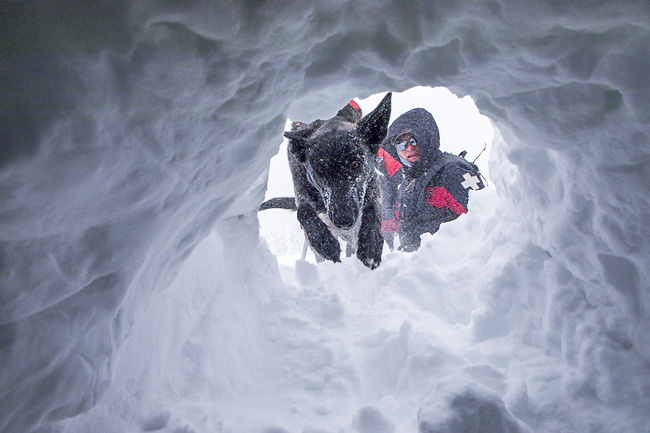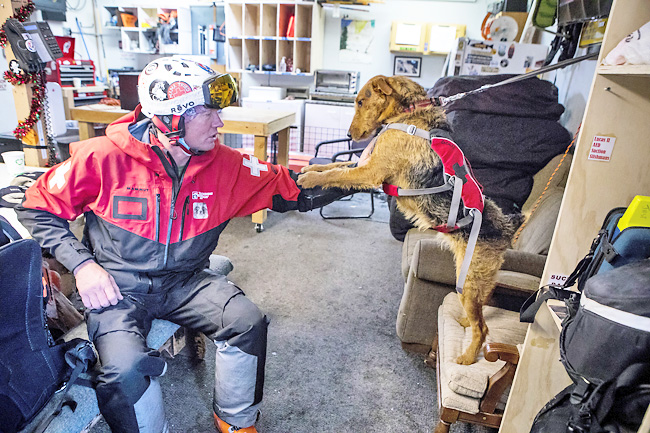Natalie B Compton
THE WASHINGTON POST – It is quiet in the Jackson Hole Mountain Resort’s staff locker room at noon. Most of the ski instructors, chairlift operators and patrol team members are in the field. Then, a whistle blows, sending a bounding two-year-old Dutch shepherd, Cache, sprinting down the aisle and around the corner.
Just like the other staff at the busy Wyoming ski resort, Cache keeps the mountain running safely. She is one of the six members of the Jackson Hole Patrol Dogs team, which aids the ski patrol in lifesaving efforts after an avalanche. If a person is buried beneath the snow, highly skilled dogs such as Cache pinpoint their location so a rescue can begin.
At the end of the aisle in the locker room, Cache reunites with the source of the whistle: her owner, Chris Brindisi, a certified search-dog handler who has been with the Jackson Hole Ski Patrol since 2000. The pair leave the locker room and head out into the snow.
Outside, Cache leaps and runs laps around Brindisi, begging him to play tug of war with a chew toy in her mouth. Playing tug is fun for her. It’s also part of her lifesaving training.
“When they’re playing tug like that, it’s like they’re ripping off the leg of an elk they just killed and they’re fighting over the biggest piece,” said assistant director of the Jackson Hole Ski Patrol Scott Stolte. “It fires them up.”
Stolte and Brindisi and other avalanche rescue dog trainers incorporate tug as a reward in training, in addition to ample praise. Over years of training, avalanche dogs learn that finding someone buried in the snow means getting rewards.



“Even avalanche rescue at the highest level, for the dog it’s a game,” Stolte said. “The game is: I’m going to go find the person buried in the snow… the reward is they’re going to find somebody and they’re going to play tug with me.”
Avalanche dogs are said to date back to the 1700s, when St Bernards accompanied Swiss monks between monasteries. Today, avalanche dogs help search-and-rescue teams around the world – from the Alpine villages in France to the Annapurna mountains of Nepal. Across the United States (US), they are mainly employed by ski resorts and non-profits. The dogs’ stories are heroic, such as in the rescue of a ski lift operator in 1982 who survived five days buried under tons of snow.
An avalanche dog’s job is to find a person buried in the snow. Their digging is a signal to rescue patrol as to where the victim is buried. Then a patrol member begins the process of extrication, which Stolte describes as one of the most difficult physical tasks. You may think of snow as light and fluffy, “but after it’s been through an avalanche and it’s been worked, hardened by the friction and the movement and the fluidity, it sets up like concrete,” Brindisi explainid.
Some of the Jackson Hole Patrol Dogs include Ziggy, an American Upland Labrador; Sparrow, an Airedale terrier; Scout, an American Labrador retriever; and Sable, a Boykin spaniel. There isn’t one breed for an avalanche dog, but most are female and on the smaller side, about 50 pounds so they can be easily transported on the shoulders of a ski patroller. But many types of dogs can fit if they can handle the cold.
Brindisi looks for working breed dogs. “Dogs that basically really want to please. They want a job,” he said. “We want a dog that’ll work for more work.”
They need to have an insatiable enthusiasm and to “go nuts” when it is time to put on the vest and head into danger. The dogs will learn to ride on snowmobiles and toboggans, stay calm on the shoulders of a patroller while they ski down a mountain, get on chairlifts, and of course, use their noses to find people. That can be detecting the smell of a person’s dead skin cells, their stress or their breath.
The dogs also have to be extremely gentle with strangers, particularly children. They will spend days roaming the resort and stopping by ski schools where students may topple over the dogs. There can’t be a risk of the dog biting; they have to love people.
“The more that they get to figure out that people are super fun and wonderful and awesome, then the more reason that they want to find you,” Brindisi said.
Not every dog will make it through avalanche rescue training. Brindisi recently had the painful experience of moving a dog out of the training programme and finding her a new home. After spending three years together, it wasn’t easy for him.
“As a handler and a trainer, you want to think you can troubleshoot and problem-solve, and to some degree you can,” he said. “But it was a square peg in a round hole. It didn’t work.”
With devices like avalanche beacons and probes, using dogs to find people buried in snow may seem archaic. But despite all of the new technology at a patrol’s disposal, Stolte said, dogs still remain an industry standard.
They are particularly essential when there’s an unwitnessed avalanche and it’s unknown if anyone is trapped. A dog like Cache could run through acres of an avalanche path and quickly determine if anyone is buried.
“The alternative would be 23 patrollers lined up single file with probes pushing through the snow to see if we find anybody, which can take hours and hours and hours and is extremely difficult and not awesome,” Stolte said.
Avalanche dogs won’t be out of work any time soon. If anything, they may be in higher demand in years to come if avalanche statistics continue in their upward trajectory.
According to Avalanche.org, which collects data from forecast centres, there have been eight avalanche deaths in the US so far this season. In the 2020-2021 season, the site reported 37 fatalities, up from 23 the season before.
But protecting skiers and snowboarders and mountain employees from avalanche risks starts long before the rescue dogs are called.
The night before the resort opens, avalanche hazard forecasters assess how much snow, wind and precipitation the mountain might get. Next, they will come up with a plan of action for the ski patrol to tackle in the morning. Jackson Hole Mountain Resort has hundreds of different avalanche paths that are broken down into 10 different routes that link together.
“It’s a very intricate dance, really, how it works. It’s very complicated,” Stolte said.
Depending on the forecast, avalanche hazard reduction may involve using explosives to trigger avalanches, putting ski tracks in the snow or just going out to evaluate potential risks in person.
“But when we do know that we’re getting a lot of snow and wind, then we’ll use explosives,” Brindisi said.
A crew will come in early to prepare the demilitarised explosives, getting them out of their secure magazines and readying them to test slopes and break up any dangerous slabs that have formed overnight. If everything goes according to plan, the team can get the mountain open for guests by 9am.
It can be a challenging and hostile work environment.
“We can go up in the morning and shove off the top in near-darkness with 70-miles-an-hour winds, and you’re working your way down (the mountain) with explosives trying to trigger avalanches,” Stolte said.
For patrollers like Stolte and Brindisi, there is also the added complication of bringing their dogs.
“It’s like bringing a two-year-old to work every day,” Brindisi said.
Cache’s original life plan was to go to the Penn Vet Working Dog Center, where she would train for a career in one of many different disciplines, from law enforcement work to cancer detection. Her brother is a police dog in Philadelphia, and her sister is an accelerant detection dog for the New York City Fire Department who helps determine whether a fire was an accident or arson.
When the pandemic hit, Penn Vet closed, and Cache was suddenly a free agent. Brindisi was looking for a dog to start training when he heard about the available Dutch shepherd.
He reached out to her owner, a veterinarian in Michigan, at the perfect time.
Brindisi drove from Wyoming to Michigan to pick Cache up, sleeping in his minivan along the way. Now, Brindisi has been housing, caring for and training Cache for about two years in Jackson. Living and working together, their bond goes beyond their professional relationship.
“She’s my family dog,” Brindisi said.






